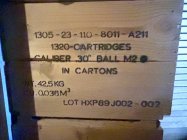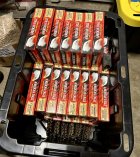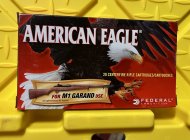Don’t use a slow burn powder
Check out the burn rates for safe Grande pressures if to slow it’ll bend the OP rod. It used to be said don’t use a powder slower than IMR 4895 .
4895 used to be the powder used by Uncle Sam for the Grande. Maybe some others will chime in on this.
This is an old wives tail.
Here, read this.
Ken Johnson
Shooters World Propellants
Prospector Training, LLC
I....have been meaning to write a book about this. From my earliest days of being a DCM shooter of M1 Garands on the weekends, to being mentored by old Marines, to being an AMU shooter, to working in Technical Services and Research and Development at St. Marks Powder.....to eventually owning and operating my own internal ballistics laboratory....I have heard of the "theory" of the bent-op rod in the M-1 Garand.
...in the early 2000's, I befriended OLD engineers from Rock Island, Winchester, CCI, and other government and industry locations. NONE of them could confirm "the theory". NONE of them had ever SEEN a bent op-rod. Despite all the parroting, the claims, the "assurances" from crusty old M-1 Garand shooters....even the oft quoted "This ammo is MADE for the M-1 Garand".....
So, being in the position of owning a SAAMI member laboratory, and having every means to run a thorough test....I did.
There are a LOT of nuances involved in ballistic testing. And honestly, if you REALLY want to challenge me on knowledge....bring your lunch. So, I'm not going to get into the "50,000 psi discussion". You quote that in an argument, and you clearly are an arm-chair Ballistician, without modern day knowledge. Study up.
Just a few Cliff notes, before I do the data-dump: I made a "blue pill" load, that approximated the current "Maximum Probable Sample Mean" for 30-06 Springfield SAAMI ammunition. This is the HIGHEST "production" pressure, as statistically suggested within SAAMI documentation for piezo transducer testing. That pressure (MPSM) is 63,800 psi. Note: Max Average Pressure (MAP) for 30-06 Springfield is listed at 60,000 psi Piezo...The intent of this portion of the exercise was to attempt to maximize PORT pressure, while keeping CHAMBER pressure within the realm of "safe limits". Surely, all would agree that IF chamber pressure were pushed FAR above "normal limits"....any damned fool could break a gun, in any number of places.
Back to the maximization of PORT pressures, just to drive the point home: The intent was to find ANY combination of projectile and propellant that would MAXIMIZE port pressure, while keeping inside "reasonably safe" SAAMI chamber pressures. Some would believe it would be "heavy bullet"....and some would believe it would be "slow powder". Well....I ran that experiment for days...turns out a little 130 grain bullet, with 70 (SEVENTY) grains of a fairly slow propellant DID maximize port pressure. Higher than any heavy bullet did....
A formal test barrel was fabricated by SATERN barrels, conforming to the min-spec dimensions of a 30-06 government test barrel chamber, bore cross-section, and port location from the muzzle. While not a "SAAMI" test barrel (but rather conforming to government drawings), it met the intent of the program. Using this test barrel, I created the "blue pill"....and tested ALL ammunition lots of both government and commercial 30-06 ammunition.
Surely some here will reference a group of gentlemen who DID instrument a true M-1 Garand with a piezo transducer TO THE GAS PORT CYLINDER of an M-1 Garand. And...they reported pressure results. Mmmmmyep. Good for them. I did that too. But I did not report those numbers, as there is NO standardized method or equipment to test/capture those numbers. Suffice it to say, that when taking into account PV=nRT, any VARIANCE IN VOLUME of the cylinder will drastically affect the recorded pressure output. Thus, the gas-port cylinder test is inherently flawed, when compared to standard industry methods. MY pressure output numbers utilized industry-standard methods, whereby the pressure is read DIRECTLY at the location of the port (as-per EPVAT modern day methodology), with no associated "free volume" to dampen the output results.
An M-1 Garand rifle was purchased from CMP, with both a "service" grade barrel, as well as a new Criterion barrel...several trigger groups, several op-rods...all with the intent to destroy this firearm by shooting the "blue pill" through it repeatedly.
Findings:
Folks have claimed (totally incorrectly) that heavy bullets....or slow powders....or SAAMI MAP pressures....will doom your M-1 Garand to certain destruction. Folks- I have passed my results to other SAAMI member laboratories, and major ammunition manufacturers. All of them have told me that they've never witnessed ANYONE ELSE, EVER test this system so exhaustively.
The "Blue Pill" load did NOT destroy any part of the M-1 Garand. I've fired in excess of 200 "Blue Pill" rounds through it (along with every other type of commercial and government ammunition), and there remains NO sign of fatigue, or of failure to feed/fire/extract. I have also fired hundreds of rounds of 200+ grain projectiles through this rifle. NO PROBLEM, if the load is kept to SAAMI pressures.
The M-1 Garand is a ROBUST firearm design, able to digest standard SAAMI modern-day ammunition, of any make, and any components, when loaded to SAAMI standard pressures.
I have long offered a bounty for a bent or broken op-rod. I NEED to examine one...but no-one has ever EVER claimed to have had one. The constraints: It must have bent or broken with a load that conforms to SAAMI chamber pressures. The op-rod must be of original non-altered condition (before it was bent). If a hand-load, I must be provided the reloading recipe.
Despite my better judgement, the attachment provides EVERYONE my raw data, proving the extent of the testing across the ocean of time, disparity of manufacturers, and methods of pressure generation. Everything herein is fired out of the pressure barrel, using modern day piezo electric transducers of industry standard, filtered low-pass Bessel active at 20kHz, the transducers and charge amps all calibrated with a dead-weight tested.
UPDATE #1
(From Ken)
Folks- PowderMonkey here again (Ken Johnson of Prospector Training, LLC). We found the attached results sheet containing more data than before. I attach it here, for historical perusal. Should anyone wish to use this information for commercial purposes, I ask (kindly) that they contribute to making me whole. I may be found on the internet, or in Crawfordville, FL.
Jeremy Cheek and I performed this testing at the laboratory. We utilized many of his M1 and M2 lots, dating all the way back to...1927! He freely donated this ammunition, so that others might be able to better understand the TRUTH of the M1 Garand, ammunition loaded and certified for the weapon (over many years), as well as modern day alternatives.















